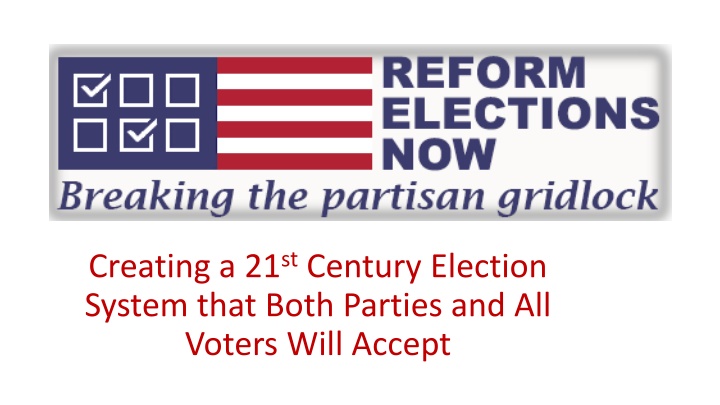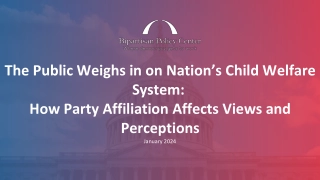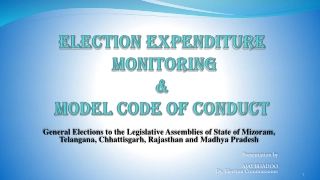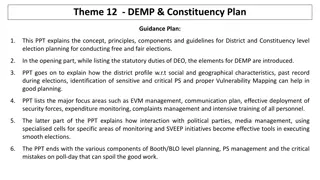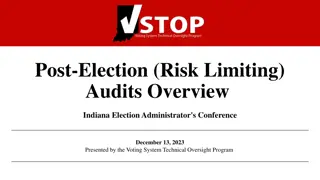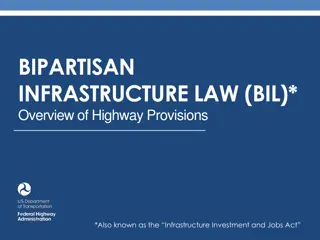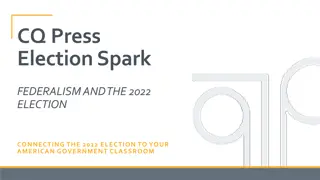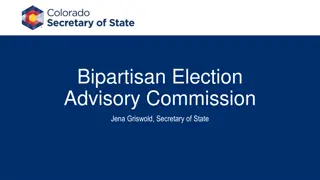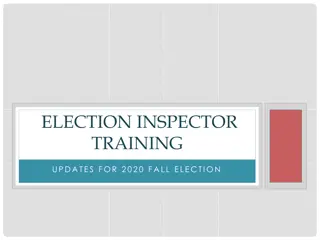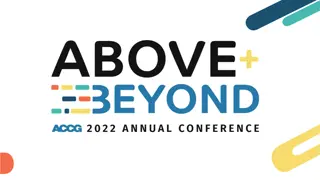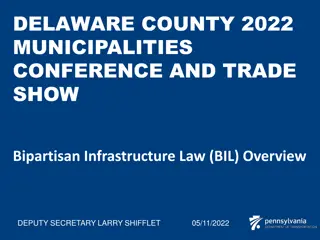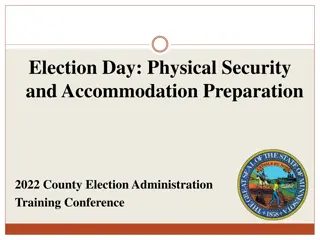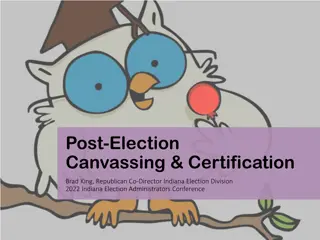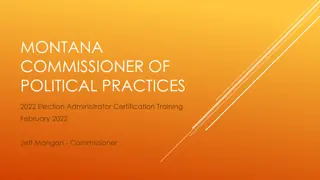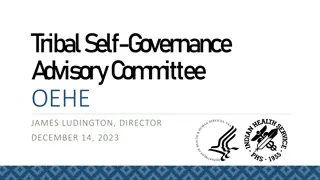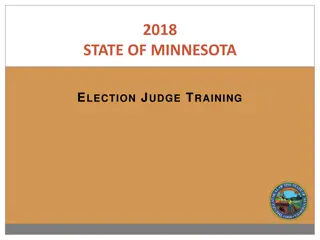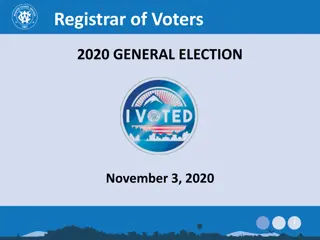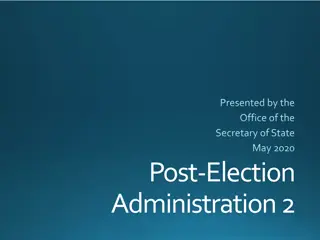Rethinking Election Systems for Bipartisan Acceptance
Amid a backdrop of contrasting electoral outcomes and widespread distrust, both major parties seek to reshape voting rules. Republicans push for tougher measures, citing fraud suspicions, while Democrats advocate for broader access to voting methods. The narrative underscores the urgent need for a comprehensive and fair 21st-century election system that all stakeholders can support.
Download Presentation

Please find below an Image/Link to download the presentation.
The content on the website is provided AS IS for your information and personal use only. It may not be sold, licensed, or shared on other websites without obtaining consent from the author.If you encounter any issues during the download, it is possible that the publisher has removed the file from their server.
You are allowed to download the files provided on this website for personal or commercial use, subject to the condition that they are used lawfully. All files are the property of their respective owners.
The content on the website is provided AS IS for your information and personal use only. It may not be sold, licensed, or shared on other websites without obtaining consent from the author.
E N D
Presentation Transcript
Creating a 21stCentury Election System that Both Parties and All Voters Will Accept
2020 2020- -Most Successful Election in 144 Years Most Successful Election in 144 Years With the pandemic raging, states rapidly made adjustments to voting systems. Many increased mail-in voting, early voting, use of drop boxes, and other steps to make it easier for people to vote. Despite the pandemic, More votes were cast in 2020 than in any other election. Only 1 election since 1908 had a higher percentage turnout. Both sides could claim victory. Democrats won the Presidency and gained in the Senate. Republicans gained in the House and in State Legislatures and outperformed every poll. 2
2020 2020- - Least Successful Election Since 1876 Least Successful Election Since 1876 Chart shows three-quarters of Trump voters incorrectly believe he won the election 75% of Trump supporters still believe he won the election. In Arizona, the Republican legislature is recounting votes in Maricopa County to determine if there was fraud. The U.S. ranks 30 of 32 countries (ahead of only Mexico & Chile) in voters believing in honesty of elections. ** If people don t trust the election results, governing will be increasingly difficult. 3 * Pew Research. **Gallup Poll
Republicans & Democrats Want to Change the Rules Republicans & Democrats Want to Change the Rules After the election, both Republicans and Democrats acted to change voting rules. Using a football analogy- Republicans have a 3 yards and a cloud of dust rushing offense, while Democrats are throwing Hail Mary passes on each down. We believe both parties are on a path to mutual self-destruction- with the U.S. and its citizens the biggest losers. 4
Republicans Work State Republicans Work State- -by by- -State to Make Voting More Difficult State to Make Voting More Difficult Republicans claim: Illegal aliens and dead people voted. Mail-in ballots led to fraud. Drop boxes created opportunities for Democrats to collect bushels of illegal votes. Voting machines transferred votes from Republicans to Democrats Democrats manufactured millions of votes after the election, and Poll workers acted illegally to help Democrats. While there is scant evidence, Republicans are trying to roll back the changes that were made to accommodate voters during the pandemic. Republicans have introduced 465 bills in 47 states all designed to make voting more difficult. 5
Republican Legislation Includes Republican Legislation Includes Removing power from Secretaries of State and giving it to the State Legislature. Restricting power of local election boards. Restricting mail-in voting and eligibility. Requiring notarizing of mail-in ballots. Limiting drop boxes. Limiting early voting times. Reducing time for ballots to arrive at the polls. Requiring voter I.D.s. Banning distribution of water and food to voters waiting in line. Eliminating mobile voting centers. Allowing state legislatures to override voting results. Enacting laws to arrest poll workers for mistakes or bad acts. 6
Republicans Think Mail Republicans Think Mail- -in Voting Works Against Them in Voting Works Against Them In 2020, 59% of Democrats voted by mail compared to only 30% of Republicans. Because many more Democrats voted by mail in 2020, Republicans think mail-in voting works against them. 7 *Charles Stewart- MIT Election Lab. Dec. 15, 2020
Republicans may be fighting the wrong war Republicans may be fighting the wrong war While mail-in voting worked against Republicans in 2020, the reasons may not apply to future elections. Democratic states like California, Oregon, and Washington, have the highest mail-in voting percentages, making it appear as if Democrats prefer mail-in voting. The pandemic was most severe in cities, where more Democratic voters are located. Trump declared war on mail-in voting, likely convincing many of his supporters to vote in person. Mail in Vote Margins by State * However, exempting 2020, mail-in voting has not benefitted either party. While Democrats had mail-in voting majorities in 2020, Republicans won mail-in in the same states in 2018. In Oklahoma, Republicans won Mail-in by 26 points in 2016. Democrats won by 18 points in 2020. 2016 2020 North Carolina R+3 D+42 Oklahoma R+26 D+18 Georgia R+2 D+38 Alaska R+15 D+19 In 2020, the Democratic margin in mail-in was due to the pandemic and to Trump, not to the mode of voting. SoutH Carolna R+1 D+31 Arkansas R+17 D+24 Florida R+2 D+18 8 *What Absentee Voting Looked Like In All 50 States-Nathaniel Rakich and Jasmine Mithani
In 2018 Republicans Won Mail In 2018 Republicans Won Mail- -in Votes In Florida in Votes In Florida In 2018 in Florida, Republicans cast 54,208 more mail-in votes by than did Democrats. Democrats cast more in-person votes. Ron DeSantis won the Governor s election by 32,463. Rick Scott won the Senate election by 10,033 Mail-in votes were the margin of victory for Republicans. According to Prof. Michael McDonald from the University of Florida, When you have a system of elections that has multiple methods by which people can vote mail ballots tend to be the most Republican of the group. If mail-in votes enabled Florida Republicans to win the major state races in 2018, why are Republicans fighting so hard against mail-in voting? Two-words- Donald Trump 9
Why Republicans Will Lose! Why Republicans Will Lose! Republicans are fighting a battle that will backfire on them. Curtailing Voting by mail may not benefit Republicans. With no pandemic, in-person voting patterns should return to normal. Older and rural voters, both Republican demographics, are among major groups that vote by mail. Restricting voting may not benefit Republicans. Making voting more difficult has not had a huge effect on turnout. These restrictions could actually energize Democrats and turn independents against Republicans. After the Supreme Court invalidated portions of the Voting Rights Act, minority turnout actually increased. Giving the legislature power over elections will benefit Republicans while they are in control. Should they lose, Democrats will utilize the powers against them. Creating laws to arrest poll workers may make it harder to run elections and alienate older people who make up most of the poll workers. 10
Democrats Democrats- - HR HR- -1 1- - For the People Act For the People Act While Republicans are introducing specific bills in almost every state, Democrats have focused on HR-1- the For The People Act. HR-1 is 791-page wish list that both Democratic legislators and political commentators have called aspirational. Of course, most of its supporters have not read the 791 pages. Aspiring and succeeding in it are not the same. A football quarterback can aspire to throw an 80-yard touchdown pass on each play. That does not mean the pass will be completed. HR-1 includes everything aa true Democrat could wish for and them some. 11
HR HR- -1 1- - Title 1 Title 1- - Voting Access Voting Access Voter Registration Modernization Act of 2019 online registration and updates on status of registration. Automatic Voter Registration Act of 2019 Same Day Voter Registration a. Conditions on Removal on Basis of Interstate Cross-Checks b. Requirements around allowing people with disabilities to register c. Prohibiting Voter Caging d. Prohibiting Deceptive Practices and Voter Intimidation. e. Democracy Restoration- giving ex-felons the right to vote. f. Voter Verified Permanent Paper Ballot g. Requirements for Counting Provisional Ballots h. Early Voting Requires states to offer the opportunity to vote early starting no less than 15 days before the election. i. Voting by Mail Amends HAVA re opportunity to have a mail-in ballot for any reason. j. Absent Uniformed Services Voters and Overseas Voters k. Poll Worker Recruitment and Training l. Enhancement of Enforcement of 2002 HAVA m. Federal Election Integrity prohibits a state election official (unless recused from office) from playing any part in a campaign. n. Promoting Voter Access Through Election Administration Improvements 12
HR HR- -1 1- -Title II Title II- -Election Integrity & Title III Security Election Integrity & Title III Security Title II Election Integrity a. Reaffirming Commitment of Congress to Restore the Voting Rights Act b. Cites obstacles to providing fair access for Native Americans, c. District of Columbia Statehood d. Granting U.S. territories the right to vote. e. Congressional redistricting reform. f. Stop Automatically Voiding Eligible Voters Off Their Enlisted Rolls in States Acts, or the Save Voters Act. Title III Election Security a. Subtitle A Financial Support for Election Infrastructure. Grants for Conducting Risk Limiting Audits, b. Security Measures Calls for timely information about threats to the election process. c. National Commission to Protect U.S. Institutions and develop a strategy to address the threat of a foreign or domestic actor, carrying out a cyber attack, influence operation, or disinformation campaign. 13
HR HR- -1 Campaign Finance 1 Campaign Finance Title IV Campaign Finance Transparency a. Panama Papers foreign/terrorist funding through real estate transactions. b.Regulation of Certain Political Spending c.Honest Ads Act d.Stand by Every Ad Act-Gives detailed requirements for endorsements e.Secret Money Transparency. f.Shareholder Right to Know. g.Disclosure of Political Spending by Government Contractors h.Limitations and Disclosure Requirements for Presidential Inaugural Committee Title V Campaign Finance Empowerment a.Citizens United Decision. Recommends an amendment to the Constitution to distinguish between persons and artificial entities such as corporations. b.Congressional Elections: My Voice Voucher Pilot Program. Freedom From Influence Fund. c.Presidential Elections-Modifies formula for matching contributions and limits funds from candidates families. Title VI Campaign Finance Oversight Restoring Integrity to America s Elections Act. a.Changes the composition of the FEC b. Stop Super PAC Candidate Coordination Act 14
HR HR- -1 1- -Ethics Ethics Title VI- Ethics a.Supreme Court Ethics Calls on Judicial Conference to issue a code of conduct judges and justices b.Tightens 1938 foreign agent registration c.Lobbying Disclosure Reform d.Recusal of Presidential Appointees. Title VIII Ethical Reforms for President, Vice-President and Federal Officers and Employees a.Executive Branch Conflict of Interest Restrictions on private sector payments for government service. b. Presidential Conflicts of Interest Act of 2019 - c.White House Ethics Transparency Act of 2019 d.Executive Branch Ethics Enforcement Act of 2019. e.Conflicts from Political Fundraising Act of 2019. f.Transition Team Ethics Improvement Act. g.Ethics Pledge for Senior Executive Branch Employees. Title IX Congressional Ethics Reform a.Requires Members of Congress to Reimburse Treasury For Amounts Paid as Settlements and Awards b.Conflicts of Interest c.Campaign Finance and Lobbying Disclosure d.Access to Congressionally Mandated Reports Act Title X Presidential and Vice Presidential Tax Transparency a.Presidential and Vice Presidential candidates must submit 10 years of tax returns. 15
HR HR- -1:Too Complex to Pass 1:Too Complex to Pass The question Democrats should be asking is why is HR-1 such an omnibus bill? Many of the pieces of the voting segment make sense and could receive more Democratic and even Republican support. By Including issues such as making D.C. a state, allowing votes in territories, giving Congress power over redistricting, making rules for state voting laws, establishing campaign finance rules, providing financing for candidates, and establishing ethics rules, many of which are focused on Donald Trump and his team; HR-1 becomes a much more complicated bill to pass. It also creates more legal challenges to a Republican dominated Supreme Court. Several Senate Democrats have already come out against HR-1, meaning there is currently no majority. However, even if they change their votes, the only way to pass HR-1 in the Senate would be for the Democrats invoke the nuclear option and do away with the filibuster rule. 16
Why HR Why HR- -1 Could Be A Disaster For Democrats 1 Could Be A Disaster For Democrats Eliminating the filibuster to pass HR-1 could spell doom for Democrats. Based on the number of smaller states that skew Republican and historical results, Republicans are likely to reclaim the Senate. When this occurs, Democrats, without the cushion of the filibuster, will find most of their policies quickly undone. During Obama s administration, Democrats changed the rules so they could appoint district judges. When Republicans gained control, they used this change to appoint Supreme Court Justices. In the words of Dr. Phil, How s that working for you, Democrats? 17
Designing an Election System Designing an Election System While Republicans and Democrats are fighting over voting rules, no one is focusing on how to create an election system that works for all the people. We have an election system that was designed for a small number of land-owning white dudes in the 18th century. We now have 21st Century technology that should enable us to track every vote in every election. The only problem is that we have two parties that would rather fight than develop solutions on which voters can rely. Before making recommendations, let us look at how the current system works. 18
Registration Registration- -Garbage In Garbage Out Garbage In Garbage Out GIGO is a computer term applicable to our voter haphazard registration system. . People register by mail; in person; online; at motor vehicle, armed services, public assistance, disability, and other state offices, through advocacy groups, and in many other ways. Such a complex system creates increased likelihood of errors. There may be no effective controls over only citizens registering. States have no effective way of monitoring when people move or die. People who have residences in more than one state can often register and vote in both. Voters are often purged from voting lists for arbitrary reasons. Without effective data bases in each of the states, voting issues will be perpetuated. 19
Maintenance of Registration Lists Maintenance of Registration Lists If registering is haphazard, the system of maintaining registration is even worse. States routinely remove voters for arbitrary reasons. In 2018, 17,300,470 voter were removed from state voter lists. The most common reason was the failure to return a notice from the State Election Bureau. * Cause of Removal Moved out of State Death Failure to return confirmation notice Voter s Request Felony Conviction Mental Incompetence Other 24.7% 21.6% 35.3% 3.1% 2.5% 0.08% 13.6% Indiana (28.7%), Virginia (16.3%), and Wisconsin (16.2%) removed voters at twice the national average. In Wisconsin, more than 56% were removed for failure to return the confirmation notice. 20 *Election Administration Voting Survey for the 116th Congress
States spend little in maintaining voting lists. States spend little in maintaining voting lists. States remove people for not responding to letters, but the state sends out very few letters, so voters are removed arbitrarily. In 2018, Notices were sent to 11.6% of all registered voters. 11.7% of these or 1.8% of all voters--responded. 38% of the responses were marked invalid, meaning only 1.1% were marked valid. N.Y. , with 13.9 million voters, reported 16,980 valid confirmations. N.J., with 3.2 million voters, reported 0 valid confirmations. Michigan, with 4.3 million voters, reported 119 valid confirmations in 2018 and 64 in 2016. How do you maintain a registration list with almost no confirmations? The IRS knows its taxpayers. Social Security knows its contributors, but somehow the Election Bureau does not know its voters. 21 *Election Administration Voting Survey for the 116th Congress
Voting By Mail Voting By Mail While maintaining a registration is complicated, the problems continue when the voter tries to cast a ballot. Votes can be cast by mail or in person. In most states, the mail-in voter has no idea if the vote has been received and accepted. In 2016, 318,728 mail-in votes were rejected. * This total does not include votes that were lost in the mail. 27.5% were rejected for non-matching signatures, 20.0% for no signatures, and 23.1% for arriving late (because of the USPS). How do poll workers decide if a signature matches? To avoid problems with the USPS, many voters in 2020 turned to drop-boxes, which are now a Republican bugaboo. 22 *Election Administration Voting Survey for the 115th Congress. **2016 Survey of the Performance of the American Elections, Charles Stewart M.I.T.
Voting in Person Voting in Person When voting in person, the voter goes to a polling place. There may be a long line, often more than one hour long. The voter enters the polling place and shows some form of I.D. The poll worker looks in a paper book to see if this name appears and then decides if the I.D. is valid. Some people are turned away because they do not have the correct I.D. If voters are in the wrong polling place, they can be given a provisional ballot or sent to another polling place. Some people- according to Donald Trump and the Republicans- are allowed to vote illegally. The poll worker has no way of knowing if this person has voted by mail or if this person in another state. In 2016, 615,528 provisional votes were rejected. * Most were rejected because people went to the wrong polling place or did not have proper identification. An estimated 247,000 votes were lost because of long lines. ** * *Election Administration Voting Survey for the 115th Congress. ** Charles Stewart-MIT 23
Can Prisons Care for Senior Citizen Poll Workers Can Prisons Care for Senior Citizen Poll Workers Republicans have introduced legislation to charge poll workers with a crime if illegal votes are discovered. 24% of poll workers are 71 or older. 32% of poll workers are 61-70. If these new laws are going to be enforced, our prison systems are going to have to open Elder Care divisions. 24
Outdated Voting Machines Outdated Voting Machines When voters do vote, they are using machines that are frequently relics. 45 states use voting machines that are no longer manufactured. 40 states use voting machines that are at least 10 years old. If machines break down, votes can be lost, and voters can be turned away. 16 States use machines that do not have paper back up. How can results be verified if machines break down or are hacked if there is no paper backup? Hacking With our outdated technology, there is no way to tell if machines were hacked. Hacking is a real threat and we do not have good systems for preventing it. 25
Processing & Counting Processing & Counting After the voter has voted, most states wait until the polls are closed to start processing and counting. In 2020 in N.Y., counting did not start until 7 days after the election. Fortunately, no one cared about N.Y. s votes. If processing and counting do not start until the polls are closed or later, there is no way to cure mistakes made on mail-in ballots or provisional ballots. In the 2020 election, all states with disputed results did not start counting until Election Day, and all but one did not start processing before Election Day. 26
Slow Counting Slow Counting- -Quick Reporting Quick Reporting While states wait to start processing and counting, they release results, precinct by precinct as soon as they are available. In 2020 Many states reported in-person votes first and then mail-in votes. For in-person votes, most states reported rural counties first. Thus, much of the early votes went to Trump. In Georgia, Pennsylvania, and Michigan, Trump ended Election night with a big lead, only to see it evaporate as cities reported and mail-in votes were counted. Since Trump had proclaimed dead people were voting in cities and mail-in votes would rig the election, his supporters became suspicious as they saw urban and mail-in votes swing states away from Trump. 27
Post Election Audits Post Election Audits Once the votes are counted, if there are disputes, we are woefully unqualified to handle them. After the 2020 elections, Republicans in many of the swing states called for post election audits. Counting is still continuing in Arizona, with Trump claiming fraud. An effective audit requires a systematic approach that all voters will accept. Most of our states are unprepared to handle these audits. According to Verified Voting,* only one state has a excellent audit system. 24 states have inadequate audit procedures, and 14 states have audit procedures that need improvement. 28 *Verified Voting safeguarding elections in the digital age https://www.verifiedvoting.org
Designing a Better System Designing a Better System For the remainder of this presentation, let us assume that we are a group of nonpartisan politicians, MBAs, and technology experts serving on a Presidential Commission. Our simple task is to design a 21st Century election system that will satisfy Democrats, Republicans, and Independents, and resolve the issues over which the two parties are at war. 29
What People Want from Their Elections What People Want from Their Elections While the parties are at war over voting rules, people agree on many of the major issues. According to Pew Research: * 82% of voters favor of voting machines printing a paper backup for votes 78% of voters favor of providing at least 2 weeks of early voting. 76% of voters favor of requiring people to show a government sponsored I.D. prior to voting. 70% of voters favor allowing people convicted to felonies to vote after their release. 68% of voters favor making Election Day a holiday. 61% of voters favor automatically registering citizens. According to yougov.com, 85.6% of Americans think it is easy to register and vote. ** With citizens largely agreeing, it should be easy to design an election system that works. *Pew Research, April 2021, **yougov.com- April 1, 2021 30
Voting Goals Voting Goals Here are some simple & achievable voting goals. 1. All citizens should be registered to vote. Non-citizens should not be eligible to vote. 2. States should have an easy way of maintaining their voting lists, including tracking people who have moved, registered in another state, or died. 3. Voters should have to identify themselves when voting. 4. Voting should be easy and convenient in order to encourage higher participation. 5. Voting should be verifiable. 6. Processing and counting should occur when votes are cast, enabling results to be received in a timely manner. 7. States should report results in bulk, instead of dribbling them out by precinct, to prevent the type of charges that impacted 2020. 8. All elections should be audited by an independent commission. 31
All Citizens Should Be Registered to Vote All Citizens Should Be Registered to Vote The easiest way of resolving registration issues is to guarantee that all citizens are registered to vote and maintain their registration as long as they are alive. Voter registration is compulsory in many countries, including most in Europe This does not mean they have to vote or choose a particular party. Rather it means, they have a permanent right to vote as long as they remain citizens. Most other countries have automatic voter registration. Why shouldn t the U.S.? Keeping everyone registered would save the states from having to keep sending registration letters. 32
Voter Identification Cards Voter Identification Cards Every citizen who is registered to vote will receive a Voter I.D. card. People can get driver s licenses, Social Security cards, Passports, and other forms of identification. Why not voters cards? 76% of Americans think people should show an ID card before voting. A voting card would solve one issue on which Republicans focus, illegal aliens voting, and two issues on which Democrats focus, citizens being removed from voting lists and voters being hassled at the polls. The U.S. Citizenship and Immigration Services Department knows the identity of all citizens. This information can be shared with the states. With a national and an inter-state data base, all citizens should be able to vote and no citizens should be able to abuse the system. Creating a unified U.S. voter data base would solve many of our voting problems. 33
Getting a Voting Card Getting a Voting Card When a citizen is born, they can receive a voting card with their date of birth and state of residence. Any citizen that does not receive a voting card at birth can apply for one by showing a birth certificate and any other proof of citizenship. Any current citizen can apply for a voting card under the same process. If someone s citizenship is questioned, they can provide a Birth certificate, a Certificate of Naturalization, a Certificate of Citizenship, a Report of Birth Abroad of United States Citizen,or a Valid unexpired U.S. passport. When an immigrant becomes a citizen, along with citizenship papers, that immigrant will also receive a voting card. Anyone with a voting card will have the right to vote. Obtaining a voter card prior to elections will make the election process much smoother. 34
Inter Inter- -State & National Voting Lists State & National Voting Lists Once every citizen is eligible to vote and has a voting card, the next task is to maintain the registration lists. Since voters will be permanently registered, there is no need send voters confirmation letters. The major challenges are tracking when people move or die. These tasks can be handled by inter-State and national data bases. If someone moves to another state, they will interact with the government in their new state. If they register to vote, their voting card will be changed. The new state of residence will inform the prior state so the name can be removed from the voting list. When someone dies, the local funeral home or hospital will often inform the state, which will inform the Board of Elections. Corroboration can be provided by the Social Security Administration, the IRS, and other government agencies. With an inter-state and national data base, we should be able to maintain effective voter lists. 35
Voting in Person Voting in Person When a citizen arrives at a polling place that citizen will show the voter I.D. card. Poll workers will have computerized poll books directly tied to the inter-state data base. This will assure much faster and accurate processing. When that citizen goes to vote, the card will be inserted into the voting machine. As an extra level of security, the machine will send a code to the voter s phone. (97% of all voters have phones.) The voter will enter the code and then vote. Many websites use this additional level of security- why not voting machines? If the voter is at the wrong precinct, the voting machine will have the capability of transmitting the vote to the correct precinct. These steps will ensure that all registered voters, but only registered voters, are able to vote. With computerized poll books and Voter I.D.s, it will be much easier for polling places to handle early voting, so voting days can be expanded, making it easier for everyone to vote. 36
Voting By Mail Voting By Mail When a citizen votes by mail To avoid late counting and provide the opportunity for curing , all mail-in votes should be delivered at least three days prior to the election. Most citizens know how they are going to vote. Why wait? Mail-in voters should be able to go online and track the the vote, just as they track a Fed Ex or UPS package. If the vote does not arrive, the citizen can request another ballot. People can also deposit ballots in convenient drop boxes. Upon arrival at the polling place, mail-in ballots will be inserted into voting machines for processing. The voting machine will send a code to the voter s phone confirming the vote. The voter taps in the code and the vote is counted. By making the voter type in a code, issues with drop boxes and mail-in votes are resolved. If there is a problem with the vote, the voting machine will inform the citizen and steps can be taken to cure the error. With these simple steps, voters can be assured that their votes are counted, and all voters can be assured that no one is taking advantage of the system. 37
Exceptions Exceptions As in any system, there will be people who can not handle these issues. These include: Elderly nursing home residents Native Americans Former felons People without cell phones People with specific disabilities Military and overseas voters Separate systems can be established to handle these groups. Poll workers can visit a nursing home or assisted living facility to confirm and collect every ballot. The same process can be utilized on reservations for Native Americans. Former felons can have a special database to reclaim their voting rights. People with disabilities or without cell phones can request special assistance. Military and overseas voters should be offered the opportunity to vote electronically. Providing special assistance to individuals or groups that are exceptions will make it easier for everyone to vote and add a level of security to the voting system. 38
Voting Technology & Verifiable Voting Voting Technology & Verifiable Voting Given the time and money spent adjudicating the 2020 election, it is ludicrous that most states are using machines that are more than 10 years old, and that many have machines without paper backup. Companies do not operate with 10-year-old computers. Few people have 10-year-old cell phones. Why does your 5-year-old grandson use a newer computer for games than our election bureau does for vote? Do we actually need voting machines, or could votes become an APP on other devices? While states control elections, the elections are for Federal positions. Accordingly, the Federal government should. Create new standards for voting machine technology. Provide the states with financing to purchase this technology. Require that all voting machines have a paper back-up so that every vote can be verified. 39
Processing & Counting Upon Receipt Processing & Counting Upon Receipt When you pay a bill early, does the company hold your check until the due date? When you arrive early at the theater, does the usher tell you to wait for your seat until 10 minutes before curtain time? Is there a logical reason for waiting until the polls close to process and then count votes? States that do process and count early have never had a major leak. Counting early relieves the pressure of the surge of Election Day votes. This will allow states to permit voters to cure errors and still report in a timely manner. 40
Reporting the Vote Reporting the Vote The gurus on TV love to analyze votes as they are reported on a precinct-by-precinct basis. But for many, this can lead to mass confusion, as it did in 2020. In most states, same day votes are counted first, even though mail-in votes were received earlier. Rural counties tend to report earlier than urban counties. In 2020, when many people went to sleep, it appeared as if Trump had won Wisconsin, Michigan, Pennsylvania, and possibly Georgia. Through the night and the next day, Democratic votes flooded in. Many Republicans decided the election had been stolen. If states had waited until all of the votes were in before releasing the results, it would lower election night drama, but it would also limit the controversy. 41
Post Election Audits Post Election Audits When corporations file Annual Reports, an independent accounting firm audits the results. Investors don t want management to make up its own numbers. Imagine what would have happened if Enron, WorldCom, Theranos, Madoff and others did not have someone independent checking their books. When states report election results, voters are willing to leave the determination of the results to the politicians, many of whom are running for election. Why do we insist on auditing corporations, but not elections? Every state should have an independent audit board composed of audit professionals to audit every election. With such Boards, we would not be playing the types of games they are currently playing in Arizona. After each election, the Audit Board shall publicly issue a report detailing its findings. With a public report from a nonpartisan professional entity, trust in elections should increase. 42
U.S. National Election Commission U.S. National Election Commission Given the current level of polarization, we do not think the two parties are will work together to resolve election issues. Each appears more interested in chasing partisan goals. To improve the registration, voting, processing, counting, reporting, and auditing processes, we should form a new nonpartisan U.S. National Election Commission. The Commission s task will be to develop processes and technologies for conducting elections. This commission should include: Leaders of both parties. IE. Presidents Obama and Bush Leaders of technology companies, IE. Tim Cook & Satya Nadella, who can help with technology. Leaders of auditing companies, who can create an auditing process, Representatives of states. It is time to rethink how we run elections? 43
Conclusion Conclusion Fixing our election system with 21st Century technology should not be that complicated. We need: 1. Universal voter registration. 2. Voter ID cards 3. A national & inter-state data base system to maintain all registrations. 4. Technology that confirms the identity of every voter including computerized poll books for poll workers and automated voting machines or APPs that can communicate with voters, allowing voters to cure any problems. 5. More early voting time and secure drop boxes. 6. A back-up paper trail for every vote to enable verification in case of hacking or disputes. 7. Processing and counting of ballots when they are received. 8. Reporting of results on a state-wide basis instead of piecemeal. 9. Auditing every election by a nonpartisan, independent, and well-trained audit team. 10. Establishing a National Election Commission composed of leaders of both parties, independents, and leaders of major technology companies to develop new technologies and new systems. With the types of technology currently available, it is time to leave the 18h Century and develop a 21ST Century voting system. 44 Peter Siris, May 18, 2021
